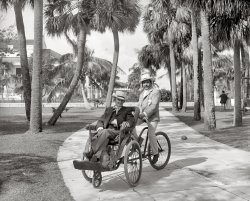
MAY CONTAIN NUTS

Search Shorpy
SHORPY ART

Framed or unframed, desk size to sofa size, printed by us in Arizona and Alabama since 2007. Explore now.
Join and Share
Ad-Free Shorpy
Shorpy is funded by you. Patreon contributors get an ad-free experience.
Learn more.

Recent comments
- Beautiful composition
- Meh
- Amazing house!
- Robie House Roof(s)
- Move to Berlin and SAVE!
- There is an interesting novel set here.
- I Was In Berlin
- Pronunciation
- Shell of a Shell
- Never been there but
- BUR-lin
- Hand-made smokes
- Birthplace of Tupperware, or at least its inventor
- Pulp
- Remarkably unchanged in 84 years
- The church is still there ...
- Talk about a smoke show
- Electric Hansom Cab
- I wondered the same thing.
- The location in 2009
- Pill Pusher
- Roll your own
- Rugged and real!
- Civil War history
- Early EV?
- A Charles Purcell - Mama Cass Connection
- Uncle SAAM
- Obfuscation
- One Chocolate Soldier rode away
- Victor Marquis de la Roche
Member Photos
The Shorpy
Printporium
Printporium
Search Shorpy
Search results -- 30 results per page
- The Dennis: 1901
- ... beaches.'
Not wheelchair compliant It appears the hotel is not ADA compliant. There is a wheelchair at the bottom of the stairs ... transition.
Earlier generation While the Dennis Hotel is still used by Bally, this picture is of an earlier incarnation of ... Posted by Dave - 06/08/2016 - 7:21pm -
![The Dennis: 1901 "The Dennis, Atlantic City, 1901." Decades before The Donald came to town. 8x10 inch dry plate glass negative, Detroit Publishing Company. View full size.
Lady on leftEdith, I swear if it get any hotter I'm going swimming clothes and all!
Second Boy from the right"Hey Elmer, check out the ankles on that chick"
No towelsMust have been an extra sandy experience, back then.
The Dennis"You'll love our pine-scented beaches.'
Not wheelchair compliantIt appears the hotel is not ADA compliant. There is a wheelchair at the bottom of the stairs on the left. Looks like the user is hobbling up the stairs to her room. I hope they didn't put her on the top floor.
No light colored parasols here, just dark rain bumbershoots to hide under.
I really enjoy looking at these pictures on my tablet. The spreading of the fingers zoom feature allows one to check the fine detail. Keep up the good work!
[The vehicle at the foot of the stairs is a "rolling chair," used to convey guests along the Boardwalk. - Dave]
Trees on the beachWhy are all the trees stacked up on the beach in front of the fence? Some kind of erosion control?
Strange effect The kid in front of the two ladies looks like he fell out of a Winslow Homer painting and landed on the beach.
Trees on the beach, a Jersey Shore traditionAlthough those don't look like Scotch Pines and Doug Firs, they may be there for the same reason hundreds of New Jersey towns, at least throughout my youth, used to collect used Christmas trees at curbside and send them on a seaside excursion. Yes, it was for erosion control, they claimed... possibly to keep the sands from swirling and shifting during the rough winter-spring transition.
Earlier generationWhile the Dennis Hotel is still used by Bally, this picture is of an earlier incarnation of the hotel:
"The latest version of the Dennis, pre-casinos, was constructed between 1919 and 1925, Kutschera said. It was built in the French regency style, with a distinctive mansard roof."
[Other Shorpy photos show mansard roofs present as early as 1905 and 1908. -tterrace]
Where?Anyone have any idea of where in AC this hotel was. I will be going to AC in 3 weeks and would like to see what's there now.
[It's still there, now incorporated into the Bally's complex. -tterrace]
(The Gallery, Atlantic City, DPC, Swimming)](https://www.shorpy.com/files/images/SHORPY-4a09096a1.thumbnail.jpg)
- Ish Kabibble: 1950s
- ... smoke permeating the air in the dining rooms, casinos and hotel rooms. The bright neon lights and the colorful slot machines beckoning ... tells me it's on page 105.
1956 or later Fremont Hotel opened 5/56
(ShorpyBlog, Member Gallery, Tonypix) ... Posted by Tony W. - 09/17/2011 - 8:16pm -
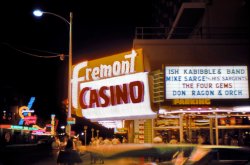
- Liberty Theatre: 1935
- ... the old city that was razed. At the site are the immense Hotel Intercontintal and the Pan-Am Life Building.
View Larger ... Posted by Dave - 09/12/2011 - 4:58pm -
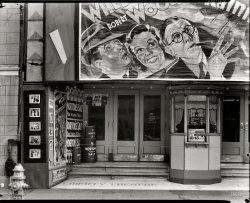
- Keeler's Korner: 1908
- 1908. "Keeler's Hotel, Albany, N.Y." The fire-escape-festooned establishment last glimpsed ... Fire escape confusion It's obvious how a guest of this hotel might get to the second floor, but for the life of me I can't see how ... William Keeler died in 1918, and as it turned out his hotel did not outlive him by very long. Just over a year later, the building ... Posted by Dave - 05/11/2021 - 1:38pm -
![Keeler's Korner: 1908 1908. "Keeler's Hotel, Albany, N.Y." The fire-escape-festooned establishment last glimpsed here. 8x10 inch dry plate glass negative, Detroit Publishing Company. View full size.
First Floor LaddersDoesn't seem to be any way to get from the first floor to the ground unless someone shows up with a ladder. Either that or I am missing something.
Fire escape confusionIt's obvious how a guest of this hotel might get to the second floor, but for the life of me I can't see how they might get from there to the sidewalk. That's a long jump.
Gardner Cotrell LeonardIn the late 19th century, Gardner Cotrell Leonard developed the system for Academic Regalia; graduation caps and gowns used in American colleges and universities and produced and sold the caps and gowns via his family's dry goods business: Cotrell & Leonard of Albany, NY. The firm, a retailer of furs, shoes and hats, located at Nos. 472-478 Broadway, Albany, NY, produced academic costume, caps, gowns and hoods, pulpit and choir gowns and judges' gowns. G.C. Leonard was also editor of "Songs of Williams" a collection of songs sung at Williams College in Williamstown, MA.
Joshua Cotrell, grandfather of Gardner, established his store selling fur hats and caps at on South Market St. (Broadway) in 1832. By 1848 his prosperous business had moved to State St. In the late 1860s his son Edgar and son-in-law Daniel Leonard came into the business; upon Joshua’s death the late 1870s they changed the firm name to Cotrell and Leonard, In 1884, the company, much expanded and selling a full range of furs, traveling garments and accessories, moved to the Broadway address ( where Tricentennial Park is located today).
As I suspected...William Keeler died in 1918, and as it turned out his hotel did not outlive him by very long. Just over a year later, the building burned in an early-morning fire on June 17, 1919. The fire was detected around 3:00 am, and within two hours the entire building was destroyed in what newspapers described as “one of the most spectacular [fires] in the city’s history.” The hotel’s 226 guests were all able to get out of the building, thanks in part to the abundance of fire escapes as shown in the first photo. Newspaper accounts also give credit to the hotel’s telephone operator Anna Briggam, who remained at the switchboard as long as she could, in order to call the rooms and awaken sleeping guests. However, one firefighter was killed in the blaze, after a wall collapsed on top of him.
More on William Keeler and the hotel here:
https://lostnewengland.com/2020/12/keelers-hotel-albany-new-york/
(The Gallery, Albany, DPC)](https://www.shorpy.com/files/images/SHORPY-4a22492a.thumbnail.jpg)
- Hanover Junction: 1863
- ... of a beat up world ... I think if I was on the Junction Hotel balcony, I would be more than a little worried about the obvious sag in ... Posted by Dave - 05/02/2009 - 8:28pm -
![Hanover Junction: 1863 1863. "Hanover Junction, Pennsylvania. Passenger train at depot." From photographs of the main Eastern theater of war, Gettysburg, June-July 1863. Wet plate glass negative by Mathew Brady or his assistant. View full size.
Look closerThere is a man in a stovepipe hat just to the right of the passenger train.
A Beat-Up WorldIt always interests me to see how hammered and dilapidated everything looks in photos from this era. The train itself looks sharp and new, but man, those tracks! Imagine the ride. It's a wonder they didn't derail more than they did. The buildings look like they're barely holding together too. I know it's wartime and they had contstraints, but still, it's a harsh, dirty looking world. Wouldn't want to live there.
Mr. LincolnSurely the recognition point for Mr. Lincoln at this period is not the hat but rather the beard. I'd have to say that this photo offers inconclusive proof if only because I can't tell if the man in the stovepipe hat has a beard or a black cravat.
Maybe, maybe not.Another shot of the train, "purportedly showing Lincoln." In any case he does have that Lincolnesque hat.
NovemberSummer? There are no leaves on the trees. The Gettysburg Daily (http://www.gettysburgdaily.com/?p=1121) says the picture was taken on November 17, 1863 and shows Abraham Lincoln's train en route to the Gettysburg.
Close to homeI think Lincoln stopped here on his way to Gettysburg.
Hanover Junction Station todayhttp://www.yorkcountyparks.org/parkpages/Museum.htm
Hanover Junction is about 10 miles east of Hanover.
En RouteThis photo has been debated for years. Is it Lincoln in the photo, on his way to Gettysburg?
[There's another photo of the station, minus the train, that shows half a dozen gents in Lincolnesque headgear. - Dave]
Track GaugePerhaps it's just the angle of the camera or distortion of the lens, but is the gauge of the track on the left the same as the gauge of the track that the passenger train is on? I believe in 1863 there were still several gauges in use even in Pennsylvania. Perhaps someone could verify based on the location of the photo.
Making tracksThe gauge is the same on all of the tracks at this location. Though narrow gauge was used extensively, it did not appear until 1870. There were some wide gauge lines in use and their gauge varied quite at bit from RR to RR.
Railroad construction was still in its infancy during the Civil War. Most if not all rail was imported from Great Britian during this period. Typical weight in those days was about 35 pounds per yard, pretty flimsy by today's standards.
Ties were hand hewn; flattened on two sides with an ax. Difficult work at best.
Speaking of a beat up world ...I think if I was on the Junction Hotel balcony, I would be more than a little worried about the obvious sag in the middle. I wonder if you could feel it sink a bit as you walked across it?
All smilesThe woman on the balcony in the light colored dress has the biggest smile I've ever seen in a photo this old.
A rare Civil War smile!As already noted, there is a smile here you just have to see. Bless her!
Beard or not to beard.Lincoln cultivated beards off and on his entire adulthood. He was without one when he was shot, by the way.
(The Gallery, Civil War, Mathew Brady, Railroads)](https://www.shorpy.com/files/images/01534a.thumbnail.jpg)
- Career Girl: 1956
- ... View full size.
Bev & Ben The Beverly Hotel is now known as Benjamin Hotel.
Art Deco Building The building to the right of the Career Girl ... Posted by Dave - 10/13/2014 - 5:42pm -
![Career Girl: 1956 1956. "New York. 21-year-old Mary Cumming, a secretary in offices of designer Raymond Loewy." Who'll be first to locate this intersection? Photo by Phillip Harrington for the Look magazine assignment "Career Girl." View full size.
Bev & BenThe Beverly Hotel is now known as Benjamin Hotel.
Art Deco Building The building to the right of the Career Girl is the old General Electric Building designed in 1931 by the architectural firm of Cross and Cross. It is currently known as 570 Lexington Avenue.
Beyond Van AlenWhere is the Chrysler Building?
[There. -tterrace]
Women's attireThis was just 59 yrs. ago but I don't see even one lady wearing slacks, shorts or jeans. In fact, it even looks like none of the men are wearing jeans. Of course I prefer the comfort of "easy casual" too, but isn't it interesting to see how times have changed?
Photobomb 1.0The young guy with the Cig is stealing her limelight.
PossiblyEast 51st and Lexington?
[You got it. -tterrace]
J. Pierpont FinchWith the cigarette. I believe in him.
Childs Restaurant'The Nation's Host From Coast to Coast Since 1896'.
Checker A8The left-most vehicle, thought of as the classic New York taxicab for decades. This one must have been one of the first, if this is 1955, as they were introduced late that year.
Red/Green traffic lightsI was amazed when we moved from New York to California in 1953 to find they had inserted a yellow light between the red and green - and they also had lots of writing on the streets - like PED XING.
[I remember seeing San Francisco's unique Wiley "birdcage" two-color signals up through the 1950s; a bell rang at each change. The last one was removed about 1958. -tterrace]
Banker's HoursI don't miss banker's hours - 9 AM to 3 PM Monday to Friday and Friday from 4 PM to 6 PM.
New York's red/green traffic lightsFun2BeMe, by the time you moved to CA in '53, most places outside NYC had the amber light between red and green, and, in fact, it was right about then when NYC finally started to phase in the amber. It took NYC about 40 years to finally replace all of the red-green lights with red-amber-green ones. I am uploading with this reply a picture of an old NYC red-green signal with an even older NYC street sign that I own.
(The Gallery, LOOK, NYC, Phillip Harrington)](https://www.shorpy.com/files/images/SHORPY-06635u.thumbnail.jpg)
- Verified Lubrication: 1939
- ... to operate the garage service which caters to downtown hotel business. The company also operates a standard automobile service station ... Posted by Dave - 02/27/2013 - 6:06pm -
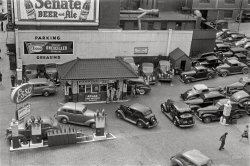
- A Vast Resort: 1895
- Hampton Roads, Virginia, circa 1895. "Hygeia Hotel, Old Point Comfort." 8x10 inch dry plate glass negative by William Henry ... a Sept. 1, 1902 order authorizing the razing of the Hygeia Hotel."
-- Newport News Daily Press .
Naphtha Launches Appears ... Posted by Dave - 07/05/2016 - 10:01pm -
![A Vast Resort: 1895 Hampton Roads, Virginia, circa 1895. "Hygeia Hotel, Old Point Comfort." 8x10 inch dry plate glass negative by William Henry Jackson. View full size.
"Shotgun"What appears to be a shotgun in the closer of the two launches is probably a line-throwing gun. They were used in rescue situations or to pass a line to another vessel.
Didn't burn downBut seven years after this photo:
"Rarely has anyone changed the landscape in Hampton Roads as dramatically as Secretary of the Army Elihu Root when he signed a Sept. 1, 1902 order authorizing the razing of the Hygeia Hotel."
-- Newport News Daily Press.
Naphtha LaunchesAppears to be a pair of them at the dock:
https://en.wikipedia.org/wiki/Naphtha_launch
I think we saw some others down in Florida
Pirate Ship?I look forward to an explanation of what appears to be a shotgun on the front seat-sea creatures?
Naphtha LaunchesThis pair of beautiful launches are propelled by naphtha boilers. They are not "steam launches" - the working fluid is a hydrocarbon rather than water.
The rationale of using naphtha rather than water as the working fluid is that a passenger-carrying steamboat must, by law, have a licensed engineer.
Note the beautiful flowing lines of their hulls. These were among the most lovely pleasure boats ever built.
At least some of this still existsBelieve it or not, at least one thing visible in the photo still exists, though from the closest street view you would not see it; this picture was taken from a now no longer existing jetty, and would be some thirty feet out in water. The Street View car, therefore, was some 6o feet off from the right angle and location to recapture the view.
I believe the street on the left is Ingalls Road, and the intersection just barely discernible on the left would be with Fenwick Road; none of the buildings VISIBLE are still there, but there are building hidden by the Hygeia Hotel that are. However, barely discernible in the distance on the right is the Old Point Comfort Lighthouse, along with a water tower [Gotta correct myself: the object on the far right that appears to be a watertower... isn't. It's an observation tower, now replaced with a more substantial tower, that rests on one corner of the fortress walls. I looked again and realized my error for calling it a water tower, since it's the exact same location as the more recent WWII era tower. And the outer gun line appears to have been built for WWII, not WWI.]; the Lighthouse is still there, along with other building which MAY be in the right side of the hotel, but the resolution there is too fuzzy for me to ascertain for sure (there are residences that date back that far on the stretch that should be visible, but some of the buildings visible on the extreme left may have been razed to make way for the outer gun line of Fortress Monroe, which is external to the historical Fort with it's moat and was build during WW1).
The site of the hotel itself is now Continental Park, with a small pavilion; immediately to the left (and it would have been in the picture if it had existed) is the location of the current Chamberlain hotel. On the other hand, the beaches have now moved significantly to the right and somewhat around the curve of the island; there are concrete breakwaters in this are of the island today.
Interestingly, if you use Google Earth to zoom in, you can still see some echoes of the Hygeia in the natural patterning of the grass growth in the park, as it grows slightly differently where the ground was disturbed for the buildings foundations, some 115 years after the hotels removal.
(The Gallery, Boats & Bridges, DPC, W.H. Jackson)](https://www.shorpy.com/files/images/SHORPY-4a09411a.thumbnail.jpg)
- Natchez: 1940
- ... Baton Rouge to Hattiesburg. We spent a week at the Alamo Hotel on the coast at Gulfport. The hotel survived Hurricane Camille of 1969, the most powerful to hit the ... Posted by Dave - 07/24/2012 - 9:50pm -
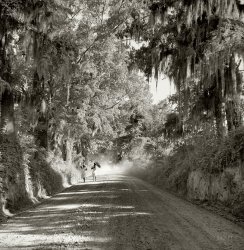
- Survivor: 1936
- ... sold for carrying passengers and their luggage between hotel and railroad station. The wooden bodies were heavy and expensive to ... Posted by Dave - 07/31/2012 - 6:45pm -
![Survivor: 1936 November 1936. "Automobile accident on U.S. 40 between Hagerstown and Cumberland, Maryland." Crash Reconstruction, Part 3, and the last shot in this mini-series snapped by Arthur Rothstein. View full size.
A reconstruction? Makes me wonder if this was just an opportune moment for a photographer or a truly major crash with fatalities. Why would they reenact if it weren't the latter?
["Reconstruction" refers to the photos being published here in the order the depicted events occurred. - tterrace]
Ah, my bad. Thanks.
Rattle-Proof Seats!The station wagon is a 1936 Plymouth Westchester.
Just when you thought technology had advanced as far as possible, Plymouth came through with the breakthrough of the century! Only in the 1936 Plymouth Westchester could you possibly obtain an innovation like "Rattle-proof seats!" I wonder why Cadillac or Rolls-Royce didn't come up with this astounding miracle.
This has to be one of the very few Plymouth Westchesters that is equipped with curtains instead of glass. The ad below clearly states that curtains were available instead of glass. It seems odd that an enclosed car would have this option, but perhaps the feature allowed odd-sized cargo and other specialty uses. Not the best feature for wintertime though.
Let's just chuck her in the back of my station wagon Joe.No Paramedics, no Gurney, No Ambulance a.k.a. the good old days.
At least it didn't cost much.
Rare AmbulanceThe "ambulance" is a 1936 Plymouth wagon. Only 309 produced. Very few, if any, survive. Much, much rarer than the '36 Fords involved in the accident (about 20,000 Standard tudors produced, and about 30,000 DeLuxe 5-window coupes made in '36).
No windowsNote the absence of glass in the side openings, just snap-in "side curtains."
In those days, "station wagons" were just that, commercial vehicles sold for carrying passengers and their luggage between hotel and railroad station. The wooden bodies were heavy and expensive to maintain. Most station wagons had heavy-duty, no-frills upholstery and few of the amenities common in cars sold for personal use.
ShoesVery interesting design for a woman her age.
(The Gallery, Arthur Rothstein, Cars, Trucks, Buses)](https://www.shorpy.com/files/images/SHORPY_8b28381a.thumbnail.jpg)
- Neighbors: 1935
- ... Price Hill or Fairmount too, with some old hospital or hotel/resort type building up top. Many of Mydans' other photos are of areas ... Posted by Dave - 07/16/2016 - 6:44pm -
![Neighbors: 1935 December 1935. "Hamilton County, Ohio. Cincinnati slum dwellings." 35mm negative by Carl Mydans for the Resettlement Administration. View full size.
Manor on the hillInteresting comparison between the falling-down, unpainted houses at the bottom of the hill and the castle at the top.
We were so poorWe couldn't even afford a tire for the spare wheel!
Eastern Avenue, 1400 BlockJeff's comment below gives the clue that solves the mystery. The Mydans photo below is captioned "House at 1400 Block, Eastern Ave., Cincinnati." The next photo down shows the same tenement with a train behind it, plus, in the upper left, the "big house" we saw here at the top of the hill.
Workshop alfrescoThat boxy looking contraption beside the little potbellied stove is a home built table saw, for cutting wood. Most likely it ran via belt power supplies by hooking a belt to a wheel of one of the vehicles. You can see the "belt pulley" coming out the side nearest the camera, but there's no other drive mechanism visible.
Vanhorne AlleyThis was one in a series of pictures that Carl Mydans took along the now-vanished Van Horne Street (previously seen here on Shorpy -- scroll down to the comments), in what's now the Queensgate section of Cincinnati.
[In which case this may have been the area circled in red below, east of the Price Hill Incline. Click the map to enlarge. See the entire map here. - Dave]
Holy CrossThis is a view of Bucktown, a segregated and now demolished African-American neighborhood on the eastern edge of downtown. The hill in the distance is Mount Adams, and the large building is very likely the old Holy Cross Roman Catholic monastery.
[Below, the big house compared to the monastery and Immaculata Holy Cross. Doesn't look like either one. - Dave]
Not Sure Where This IsThis one has me stumped. The building on the hill looks sort of like some of the incline houses, but it doesn't match up with any of them, or with the Holy Cross monastery or the art museum. We're already starting to climb up the hill where the photographer is standing, so this isn't Van Horne Street. Based on the density and type of buildings, I would guess this is somewhere around the base of Mt. Adams or Mt. Auburn, or it could be in Mohawk/Brighton near McMicken Avenue, but I can't find a record of any buildings that look like the one on the hilltop in those areas. It could also be somewhere in Lower Price Hill or Fairmount too, with some old hospital or hotel/resort type building up top. Many of Mydans' other photos are of areas along Eastern Avenue, so this could be any one of several streets that parallel it and back up to Columbia Parkway, with a Hyde Park or Mt. Lookout mansion above.
Dave beat me to itThe other photos of the same area gave a good clue with the railroad being in the background. Interestingly, the little neighborhood off Eastern Avenue that these houses were in was completely wiped out before 1956, and not even the roads remain. The house on the hill is a mansion that was part of Edgecliff College. That was absorbed into Xavier University and much of it was demolished in the late 1980s for construction of a new high rise condo building. Because of the house's setback from the edge of the cliff (har har) we can only see the second story and the roof, but you can definitely see what it is in the aerial shot I attached.
More maps!Thanks to Jeff J. for pinpointing the location. This would be just east of Eden Park. Click below to enlarge.
ExactlyWhy I find SHORPY so interesting: the research and analysis that sorted out the location of the subjects and the mystery mansion on the hill! Well done all! Proof that coming back later is always of value with Shorpy. A great educational tool.
Source for maps?I was wondering where the Cincy map was found in hopes I could find others for my area.
[There's a link to the Rumsey Map Collection in the Vanhorne Alley comment below. - Dave]
Our Lady of CincinnatiThe big house on the hill belonged to Our Lady of Cincinnati College (later Edgecliff College). It looks a little like Emery Hall.
Edgecliff College (Our Lady of Cincinnati College)To the two folks who attached the pictures of Edgecliff (overview of the campus from Jeff and the postcard from Anonymous), can you let me know where I could obtain copies of these? I'm trying to assemble an archive of the old school. Thanks. LemminPie@aol.com
(The Gallery, Carl Mydans, Cars, Trucks, Buses, Cincinnati Photos)](https://www.shorpy.com/files/images/8a00730a.thumbnail.jpg)
- Snow King: 1905
- ... for icebergs!
The Maillard That is the Fifth Avenue Hotel to the right. It was closed and demolished in 1908. The restaurant on ... Posted by Dave - 07/31/2012 - 2:54pm -
![Snow King: 1905 New York circa 1905. "Flatiron Building, corner after snow storm." 8x10 inch dry plate glass negative, Detroit Publishing Company. View full size.
Deja vu all over againIt looks as if this photo was shot just awhile after what we see in this thread.
BeautifulThis is such a great photo. The composition, mood and perspective are fascinating! And it's cool how clean all that snow is!
Putt puttThat automobile really is a "horseless carriage."
FlagpolesI count 17 readily visible flagpoles (and/or spires)--2 in use.
Also, I'm very glad my car has heat.
The city where I live, however, takes no better care of the snow-covered sidewalks than NYC in c. 1905.
How does NYC do today?
Extraordinary field of focus.Most of the photo is in focus across the horizontal and vertical planes.
Most photos cannot hold up to the intense scrutiny Shorpy provides.
This is one of the few that do.
A Familiar SceneSave for all the horses, this could be a scene from the last few weeks here in NYC. Even most of the buildings are still there.
Deja Vu VuThis photo was taken before the other one, judging by the clock.
It must have taken the photographer some forty minutes to walk across the street, set up his camera, focus and compose the shot, load the glass plate and take the exposure.
[Assuming the exposures were made on the same day. And there are more than just two. - Dave]
Widespread cold of 1904-05 winterMany records were set in that winter season. Many of the old time cold records still stand today. Arkansas's all time low temperature happened in February 1905. Minus 29 degrees is that record of 105 years and counting.
Ahoy!Keep a sharp lookout for icebergs!
The MaillardThat is the Fifth Avenue Hotel to the right. It was closed and demolished in 1908. The restaurant on the bottom floor, The Maillard, was quite famous as a candy store and French restaurant. It moved to Fifth and 35th, and then again in 1922 to Madison at 47th. James Beard frequented it and commented on its hot chocolate. Sadly the Depression was its demise.
Now and thenOne major difference is that traffic on lower Broadway runs downtown now.
Snow-white snowThe difference today is that after using salt, sand and other chemicals, the snow always looks so dirty after a couple of days! This looks so pristine!!!
Geometry exposed in the wintry airI love this shot of one of my favorite buildings for two reasons.
First, it wonderfully captures the atmosphere and light of a post-snowstorm day, not to mention many evocative period details.
Secondly, because of the way it's aimed down Fifth Avenue, this picture does an unusually good job of depicting the Flatiron's actual asymmetry, something most pictures of it attempt to disguise. Looking at this, you can readily appreciate that the building is a right triangle with its base on 22nd Street, its straight long side on Fifth, and its hypotenuse on Broadway.
(The Gallery, DPC, Flatiron Building, NYC)](https://www.shorpy.com/files/images/4a17513a-flatiron.thumbnail.jpg)
- The Sands of Time: 1906
- ... Observation tower?
[It was made from the tallish Hotel Traymore. - Dave]
Splash. Makes me want to go to the beach. ... Posted by Dave - 07/25/2012 - 3:09pm -
![The Sands of Time: 1906 The Jersey shore circa 1906. "Beach and Boardwalk, Atlantic City." Brought to you by Gillette. Detroit Publishing Company glass negative. View full size.
Bird's eye viewSo, was this photo shot from a hot-air balloon? Aeroplane? Observation tower?
[It was made from the tallish Hotel Traymore. - Dave]
Splash.Makes me want to go to the beach. Thanks Shorpy.
Up On the RoofSo what's the large cylindrical object atop the building towards the end of the pier? It appears to be made of fabric. An inflatable airship?
Or maybe just a giant advertisement for foot-long (block-long?) hotdogs?
[The sign hanging underneath reads THE AIRSHIP. Another Shorpy Mystery! It looks something like one of Melvin Vaniman's ill-fated craft. In 1910 he attempted the first air crossing of the Atlantic Ocean from A.C. in the dirigible America, but had to abandon ship near Bermuda. He was killed in 1912 when his hydrogen blimp the Akron blew up off Atlantic City. - Dave]
An idea before its timeWhere's the Barbarossa now that people are wearing Bikinis and Speedos? Gillette's advice still holds.
So much to seeAnd so little time. But, my favorite thing so far are the five gals arm in arm walking away from the camera about 40 yards to the right of the covered beach chairs.
(The Gallery, Atlantic City, DPC, Swimming)](https://www.shorpy.com/files/images/4a18197a.thumbnail.jpg)
- Fifth Avenue: 1908
- ... Fifth! That's Central Park up ahead, where the Plaza Hotel and Apple's all-night store now stand face to face.
It looked so much ... Posted by Dave - 08/09/2012 - 3:20pm -
![Fifth Avenue: 1908 New York circa 1908. "Fifth Avenue hotels north from 51st Street." 8x10 inch dry plate glass negative, Detroit Publishing Company. View full size.
Ivy-covered walls at 51st and Fifth!That's Central Park up ahead, where the Plaza Hotel and Apple's all-night store now stand face to face.
It looked so much nicer a century ago.
That vehicle in the centerlooks like an armored car.
[It's an electric taxicab. - Dave]
+98Below is the same view from April of 2006.
1906 Fifth Avenue PostcardThis postcard in my family collection shows a similar, but earlier view of Fifth Avenue.
GrandeurIt just looks to me as though life was so much richer and dignified then. I think a nation's architecture speaks a lot about the mindset of the people.
That churchAny one know which church that is on the left. At first I thought it was St. Patrick's but St. Pats is behind to the right.
A high point in Central ParkIf you look in the distance at Central Park, it looks like there is a small mountain there. Was there a hill that was excavated in the forming of the park?
Vanderbilt RowIn the foreground on the left is the Vanderbilt double mansion built by William H. Vanderbilt at 640 Fifth Avenue for himself and two daughters. In 1908, Henry Clay Frick was in his third year of living there at a reported annual rental of $50,000. http://nyarc.org/content/vanderbilt%E2%80%99s-house-dreams
You can see the surviving half of the house in 1933 surrounded by much taller neighbors in this classic Shorpy photo, next to what will become Rockefeller Center. https://www.shorpy.com/30-Rock It finally bit the dust in 1947.
And right across 52d Street is the celebrated home of his second son William K Vanderbilt, which made it to the 1920s.
So sad, bye byeI'm always a little shocked and saddened by the changes made by "progress" but this all really takes the cake. Everything appears to be gone and it all looked beautiful to my untrained eye. I've noticed that whenever I see cupolas or turrets in an old photo, you can almost bet that building will be gone. Speaking of which, my favorite building, the one just to the left with the very pointed peak, has two interesting items that I don't quite understand. One, the windows all look open, but way too "open" for this construction if you get my drift. And two, whats with the guy on the chimney?
Houses of the VanderbiltsOn the left side of the avenue, we can see several houses belonging to the Vanderbilt family: First is a part of the double house (actually 3 houses) covering the whole block between 51st and 52nd Streets, built for William Henry Vanderbilt (son of the Commodore) and his two married daughters. These houses were designed by the decorating firm of Herter Brothers and built between 1879 and 1882. Next, at the northwest corner of 52nd Street, is the house designed by Richard Morris Hunt for William K. Vanderbilt (one of the Commodore's grandsons) and built in 1879-1882. This landmark of old New York was also known as the "Petit Chateau." I'm fairly certain that the smaller house right next to it was also built for a Vanderbilt, but I can't remember which one (!) The very last building visible on this side of the street, between 57th and 58th Streets, would be the Cornelius Vanderbilt II House, designed by George B. Post for another grandson of the Commodore. This last house was built in two phases, the first in 1881-1882 and the second in 1892-1894.
Flue with a view Please tell me that that's a brave sweep taking in the view on his lunch break, and not a boring piece of statuary (to the left of the very Cinderella-looking turret)!
Re: That churchThat's the Fifth Avenue Presbyterian Church http://www.fapc.org/our-church/history which still stands at 55th Street.
St. Thomas Church at 53rdThere are actually two churches visible on the left side of Fifth Avenue - the first of which is the tower of St. Thomas Episcopal Church, at the northwest corner of Fifth Avenue and 53rd Street. The Church burned in early August 1905, but the tower reportedly survived. From this angle, in fact, it's difficult to see any fire damage; the facade of the front door of the church seems intact.
Between 1907 and 1909, the City widened Fifth Avenue between 23rd and 47th Streets, by taking 7 1/2 feet from sidewalks on each side, but by July 1909 that project had not yet reached further north, to this area.
660 Fifth AvenueThe French Chateauesque mansion second block on the left is the William K. Vanderbilt house, designed by Richard Morris Hunt. I seem to remember from an episode of A&E's America's Castles that the statue was relocated to a still existing Vanderbilt house on Long Island.
(The Gallery, NYC)](https://www.shorpy.com/files/images/SHORPY_4a22984a.thumbnail.jpg)
- Audubon Building: 1910
- ... Sts." This former office building is now the Saint Hotel. 8x10 inch dry plate glass negative. View full size.
Now Canonized And known as the Saint Hotel.
It looked better then A lot of ornate metal has been lost -- ... canceled? Both the Audubon Building and the Audubon Hotel in New Orleans changed their names within the past decade: the building ... Posted by Dave - 08/26/2021 - 9:23am -
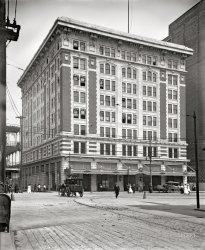
- Arlington Brewing: 1920
- ... until the building was torn down in 1959 to build a new hotel. Presumably the hotel resembles a box (doesn't all 1959 period construction).
[Key Bridge ... Posted by Dave - 09/03/2012 - 11:52am -
![Arlington Brewing: 1920 Arlington Brewing Co. circa 1920. An 8x10 glass negative that would leave your fancy-schmancy digtal SLR crying for its mommy. View full size. Nat'l Photo.
DetailWhen your pixels are molecular sized you can usually get more detail.
[The obvious difference is that in an SLR the verticals would be tilted inward toward the top because you have no perspective control. The "pixels" would probably be around the same size or a little bigger than a CCD pixel (a 12-megapixel SLR can capture far more detail than a 35mm film camera). But there would be many more of those pixels -- the image sensor in an SLR is around one square inch; an 8x10 glass plate is 80 times as big. - Dave]
Watch That First Step!Those doors on the second floor look pretty dangerous!
Prohibition VictimIf this photo was shot in 1920, the Arlington Brewing Co. had already been out of the beer business for four years. The state of Virginia went dry in 1916, and the brewery was located in Roslyn Virginia. During Prohibition it produced a soft drink called Cherry Smash. It didn't reopen after the repeal of Prohibition in 1933 and was used as a warehouse until the building was torn down in 1959 to build a new hotel. Presumably the hotel resembles a box (doesn't all 1959 period construction).
[Key Bridge Marriott. - Dave]
HayloftThat "second floor door" is where hay was stored in the stable. The exposed beam above the door is a pulley post. Wagons loaded with hay and feed would drive up and their loads would be lifted into the hayloft using block and tackle. When it was time to feed the horses, hay was dropped down a chute or opening into the stall cribs in the stable below. The iron gate is for equine access.
Arlington Brewing Co. probably used big draft horses - Belgians, Percherons, Clydesdales or the like. Barrels of beer are heavy!
And, it's still hereNot only is it incredibly detailed, but more importantly, it's still here. This negative survived by just being stuck in a box somewhere in a reasonably favorable environment. Do nothing over the next 88 years with the digital image you take today and see if anybody's able to view it in 2096.
Also, a new Shorpy pastime: Count the Bricks!
Does that faded sign say"Wiener the perfect beer?" "Wiener the Purified Beer?"
Can't quite make it out.
[Pure. - Dave]
Sharp"An 8x10 glass negative that would leave your fancy-schmancy digtal SLR crying for its mommy. "
To say the least.
An Excellent PointThis worries me too. When we cleaned out my Great Grandmothers house after she died we found a huge album of photos taken in Alaska between about 1880 and 1920.
I'm not sure what, if anything soomeone would do if they came across a bunch of my backup dvd's or and ancient external hard drive a hundred years in the future.
Hopefully technology will settle on one photo format soon and stick with it.
Those TracksThe details are beyond anything that a digital camera will record. As a rail fan, I noticed the trolley wire frog in the top left hand corner of the photo. While there does not appear to have been a siding to the building, the area was served by an Interurban electric railroad. By the mid thirties, most Interurbans were being abandoned. It's hard to tell if those tracks were still in use. But it does not look like they were.
Fancy-Schmancy?No doubt that an 8 x 10 view camera can outperform my fancy-schmancy digtal SLR, but I'll take that SLR and day over hauling around the equipment needed for that 8 x 10. Besides, I find that spending time in my "lightroom" beats those many hours spent in the darkroom over the years.
Definitely HDI was literally gasping here for a moment. Then I laughed. That has got to be one of the sharpest images I've ever seen. Obviously the photog knew his business. Then the fact that the full-size image actually contained the information for the small print:
VIRGINIA REALTY TITLE CORP.
CERTIFICATES & ABSTRACTS OF
TITLE FURNISHED TO VIRGINIA
REAL ESTATE ====
==== TITLES INSURED
OFFICE ALEX CO. C.H.VA
...made me laugh. In happy astonishment.
I'd quite like a digital SLR, though.
Sigh!Once again, the replacement building doesn't even approach the the original. But at least the new building serves a purpose - in my hometown (Joliet, IL) there used to be a similarly beautiful brewery of the same vintage as Arlington, which was torn down about 40-50 years ago for a parking lot (which the site still is today). And it's in a part of town which doesn't have much demand for off-street parking anyway.
Prohibition VictimIt certainly looks derelict in the photo, except there some kind of exhaust coming out of a small smokestack next to the larger brick chimney. Perhaps it was already producing Cherry Smash, a process which probably wouldn't require all the brewing apparatus - which I'm assuming all the fancy stacks sprouting from the rooftop are for.
Also, was that a greenhouse on the roof, or an elaborate skylight? What a beautiful building - at first glance, I thought it was a church! (I'm sure for some it would be!)
Is that a greenhouseon the roof? Nice picture.
W&ODThe tracks in the foreground were the Arlington's own Washington and Old Dominion railroad, which started out in 1847 and lasted until 1968. This shot was taken on the Rosslyn Branch, which was abandoned in the early 1960s. This part of the line is now I-66.
(The Gallery, Natl Photo)](https://www.shorpy.com/files/images/32271u.thumbnail.jpg)
- Our Confederate Dead: 1910
- ... another MacDonald's Luncheon & Cigar, as well the Stag Hotel and terminals for the Portsmouth and Berkley ferries. And: Clam Broth ... not the most pleasent of places. Mickey D's and the Stag Hotel on the corner there looks a bit unsavory, and the air looks to be full of ... Posted by Dave - 08/21/2012 - 5:18pm -
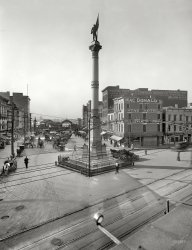
- Shallow End: 1923
- 1923. Swimmers at the Wardman Park Hotel pool in Washington, D.C. National Photo Company Collection glass ... Posted by Ken - 07/23/2012 - 6:41pm -
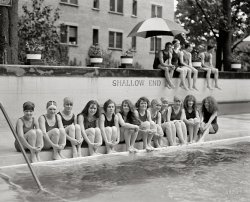
- Evening Star: 1921
- ...
Flags I wonder why the flag on the Raleigh Hotel is flying at half mast. There's a lot to look at in this pic.
D.C. ... that building now. It was Planet Hollywood before. The Hotel Harrington is still there too.
Washington Star This picture is ... Posted by Dave - 09/04/2012 - 12:57pm -
![Evening Star: 1921 District of Columbia circa 1921. The Washington Evening Star building at 1101 Pennsylvania Avenue. National Photo Company glass negative. View full size.
YMHAOne of the reasons I like this site so much is that, each day, it expands this small town boy's horizons. Had never encountered the Young Men's Hebrew Association. After a little Googling, I now know more than I did yesterday.
FlagsI wonder why the flag on the Raleigh Hotel is flying at half mast. There's a lot to look at in this pic.
D.C. StreetcarsI'm digging the street cars moving down Pennsylvania Avenue. I didn't know there were any.
There is a Fogo de Chao restaurant in that building now. It was Planet Hollywood before. The Hotel Harrington is still there too.
Washington StarThis picture is stirring a few memories.
My father started working summers beginning in 1967 when he was pursuing a post-secondary education at American University. He liked the job enough that he stayed after graduating. It was at this time the Star had some colorful events. He also went on strike with a few other coworkers. He was hired by the Washington Post when Star declared bankruptcy. I went to his workplace a few times when I was a kid. I can still smell the ink...
Washington Post in your face billboardIt is interesting that the Washington Post placed a billboard advertisement opposite their competition.
The visitors to this site frequently cite the Washington Post to clarify items in these photos; it is a shame that the Evening Star closed before its archives were digitized. The Star, an afternoon paper, predated the Washington Post and would be a valuable source of information about early Washington.
[Being out of business is no obstacle to a newspaper's being digitized. Hundreds of defunct old broadsheets from the 19th and 20th centuries are online in various archives. - Dave]
Digitized DC papersFor some more trips to Washington, DC of the past the Library of Congress has their Chronicling America.
http://www.loc.gov/chroniclingamerica/index.html
Only covers 1890-1910 but there are some interesting DC area papers. You can see old real estate development ads and often there are pictures of the "new" developments like Petworth and "Saul Addition."
There are full-text database like "19th Century Newspapers" (Gale), which has US Telegraph, Washington Globe, Daily National Journal, and National Intelligencer. "Americas Historical Newspapers" which has 27 title for DC including the Washington Gazette, Globe, Washington Federalist, Daily National Intelligencer, Federal Republican, etc.
The Washington Star photo archiveWhen they closed, they gave their archive to the District. I forget which branch it is. But there are several file cabinets full of photos.
Remember the Star well!I read the Star years ago when I lived in D.C. (1960's) and it was the best. The other one I just loved was the Washington Daily News. Small paper but had lots of fun articles and games. Irony is my father worked for the Washington Post, he just loved it there, but the Post was always huge, and I could never really get into it.
I still live near DC, and miss the DC of the past so very much.
I used to also ride those streetcars mentioned here, and they were wonderful. They were cheap and fast. We lost the best of D.C. when they removed them.
I also remember when Washington was like any other small town, and believe it or not, it was actually a small town up until around the mid 60's. Neighbors hung over fences and talked about the Lincoln Roses they were planting, and yes, every yard had them. Entire streets were blocked off for ball games, hide and seek, and you played outside until very late in the summertime. Everyone sat on porches and watch the world go by. It was a fantastic City. (And still is)
Evening StarI worked for the Star as a newsie and a jumper, even tho I didnt know we were called newsies. The best part was winning contest and going to KFC. Didn't take much to please us.
Washington Star & streetcarsThe Martin Luther King Memorial Library, a public library in downtown DC (a Mies van der Rohe Building) houses the paper archives in their Washington Room. Regarding streetcars, they might be coming back!!!
More on Evening StarThis is like old home week. I worked at the Washington Star, and later at the Post. The MLK's Washingtoniana section does have the card index from the Star, though this is by categories, with chronological entries, and the categories change through the years. It is from 1906-the seventies, maybe. Can't remember for sure. I think the plans to digitize the Star fell through for now, the last I heard. I believe that the Washington Post building may have been where that sign is. I think I've seen it on the Avenue in early pictures. As a native Washingtonian, albeit displaced, I love these old National Photo pictures especially.
Evening Star FamilyI lived in Prince Georges County and we were not rich financially but my Father GOD Bless him provide for all the kids at Home. but we were rich in lovin life and havin fun when we were kids!
It was not hard to find a way to enjoy any and everything in my small world!
The Seasons in the Wasihington,D.C. area were always spectacular!
Goin to the drug store and getting ten cents worth of candy in a brown paper bag that would last you a whole entire day!
I became a newspaper boy and then I was rich goin down to the "Drug Fair" and getting a half smoke,soda,and a bag of chips for sixty cents,no tax.
Would so love to hear from others who worked at Evening Star in mid 1960's and or newspaper boys who worked around the same time1
I was blessed to know good people who held positions in the newspaper world of The Evening Star
(The Gallery, D.C., Natl Photo)](https://www.shorpy.com/files/images/30199u1.thumbnail.jpg)
- Napoleon House: 1905
- ... at the left of the photo was attached to the old St. Louis Hotel, which fell victim to the Great Hurricane of 1915.
The solid ... Posted by Dave - 07/19/2012 - 4:32pm -
![Napoleon House: 1905 New Orleans circa 1905. "Napoleon House, Chartres Street." 8x10 inch dry plate glass negative, Detroit Publishing Company. View full size.
Grandma's roomIf this photo had been taken in 1938 that might have been my grandmother in the window. That's when she lived on the 3rd floor.
Coming, MotherYikes! It's Mrs. Bates.
Identity theft, 1905-styleAccording to this article in L'Abeille de la Nouvelle-Orleans dated Tuesday May 5, 1905, a certain John Escat was sentenced to 30 days for impersonating Joseph Labourdette.
I am depending on my limited French to translate.
John Escat showed up at the Consumers Brewery Company, presenting himself as Joseph Labourdette, proprietor of a liquor store at the corner of Chartres and St. Louis Streets. He claimed to have lost his coat and convinced the Brewery to loan him $3.
The real Joseph Labourette, when asked to repay this supposed loan, refused and this was when the deception was discovered. Escat pleaded guilty and was sentenced to pay a $25 fine or spend 30 days in jail. It appears he chose the latter.
The last sentence is a mystery: "Fogarty is said to be armed and dangerous." No Fogarty named in the rest of the article.
[Fogarty is the recorder, or judge. (Escat a ete en outre condamne a $25 d'amende ou 30 jours de prison par le recorder Fogarty comme suspect et dangereux -- "Escat was sentenced to a $ 25 fine or 30 days' imprisonment by the recorder Fogarty as suspicious and dangerous.") - Dave]
Ah! Thanks!
A table in the courtyard please.Bring me a Pimm's Cup and a Muffuletta. I shall enjoy lunch until dinner.
Geaux Saints!
Whoa, Nelly!Seeing that person in the window sent a chill up the nape of my neck. It looked to me like Hannibal Lecter in drag.
Plus ça changeView Larger Map
The iceman comethGreat picture, Shorpy does it again!
I am so jumpywhen I view these photos in high def. The people you don't see in regular view almost seem like spirits when you are scrolling along the pic and POOF they are staring back at you.
By the way, is that sewage running along the curb?
[Mud would be my guess. With perhaps a soupcon of manure. - Dave]
The Doctor is in?There appears to be a young Dalek waiting at the curb, just in front of the horse. Exterminate!
Any bar in a stormThe balcony at the left of the photo was attached to the old St. Louis Hotel, which fell victim to the Great Hurricane of 1915.
The solid Napoleon House has survived that and more recent storms. After Katrina in 2005, they were among the first businesses to reopen after electricity was restored to the French Quarter. A sign in the window announced their limited post-Katrina menu of M.R.E.s -- "Muffulettas Ready to Eat."
Throw me something, Mister!Oh to be on one of those balconies with a Mardi Gras parade passing by below. Back when you had to be cautious after shouting, "Throw me something," lest you be beaned by a coconut.
C'est la VieAs the Napoleon House this was my favorite watering hole back in the 1950's and the repository of some great, great memories. Was largely patronized by the locals then, but later changed its focus to attract more tourists with lunches featuring a rather lame po boy sandwich. You can't go home again.
Chez NapoleonThis is our absolute favorite bar to go to in New Orleans. Classical music, Charcuterie Plate and a Pimms Cup. Ah, heaven!
Buddy's BluesA line from "Buddy Bolden's Blues":
I thought I heard Judge Fogarty say:
"Thirty days in the French Market, take him away.
Give him a good broom to sweep with, take him away."
I thought I heard him say.
I can hear Buddy's trumpet echoing through those streets.
RuminationsRe: "The Old St. Louis Hospital"
In the wrought iron of the building at left, you can see the letters spelling St. Louis. I presume the remainder is lost behind the curvature of the ironwork.
Notice those glistening slabs of ice in the ice wagon.
My parents and grandparents used an "icebox," and my kids still laugh at me when I slip and call the refrigerator the "icebox".
It's incredible that routine, even mundane photos become valuable archival documents with the passing of the years.
(The Gallery, DPC, Horses, New Orleans, Stores & Markets)](https://www.shorpy.com/files/images/4a10810a.thumbnail.jpg)
- Career Girl: 1925
- ... for a party given by the Wisconsin Society at the Willard Hotel.
1935: Grace is in the receiving line for a party given by the Badger Society at the Shoreham Hotel.
1935: Grace is on the planning committee for the "annual moonlight ... Posted by Dave - 09/11/2011 - 7:31pm -
![Career Girl: 1925 Washington, 1925. "Miss Grace M. Eddy, first woman examiner for the Interstate Commerce Commission." National Photo Co. glass negative. View full size.
GraceThose glasses are just so flattering.
Miss EddyI'm sure she was a damn fine bureaucrat!
One ringy-dingy, Two ringy-dingyLily Tomlin comes to mind.
Miss EddySetting aside all of the usual snide comments about her appearance, I really would like to know more about her story after this photo was taken. Unfortunately the only result I get by Googling Grace Eddy and the Interstate Commerce Commission is to a paid archive site and I have no desire to pay $6.25 a month just to find out if the article actually deals with Miss Grace. from what little I can find out she seems to have been a very accomplished woman - far more than just a glorified secretary.
Thank You GraceI think all women of today should thank women like Grace. They made it possible for us to enjoy the freedoms we enjoy today. And it seems to me that she lived up to her name.
But of course, instead we're all worried about what she looks like.
Thanks Dave for posting her history.
Laugh if you mustLaugh if you must, fellows. But that woman probably helped control a preposterously large chunk of the US economy. How much will it cost to ship a load of grapefruit from California to Michigan? Ask Grace. Would it be OK if you started a parcel delivery company in Iowa? Not unless Grace says so.
Don't worry. She never paid for her own drinks.
Flattering Glasses?Yes, but the hairdo more than makes up for them...
Miss Jane Hathaway!Milburn Drysdale: "Miss Hathaway, would you come here, please?"
Where's Sweet Pea?I like the overbite.
Strange JobWhat, pray tell, did Miss Grace examine women for?
Grrrrrrrrr-wow!Hubba-hubba, Madame. I thought Olive Oyl was hot, but dang, baby. You can balance my ledger any time, if you know what I mean.
Where's Popeye?Where's Popeye?
Grace Eddy 1890-1981A Grace Eddy timeline, as gleaned from the pages of the Washington Post. Note in particular the final item. - Dave
1915: Purse containing $10 stolen from Grace, who lived at 2140 P Street NW, while she was at church (Epiphany Episcopal, G Street NW).
1923: Grace is on the committee planning the annual banquet of the Women's Bar Association.
1925: Grace is a speaker at a meeting of the Women's Bar Association.
1925: "Supreme Court Admits Woman." Miss Grace M. Eddy, of Wisconsin, the first woman appointed examiner for the Interstate Commerce Commission, was yesterday admitted to practice before the Supreme Court of the United States. She received her law training at George Washington University and is now treasurer of the Women's Bar Association of the District.
1927: Grace is a Maryland delegate to the national convention of the United Daughters of the Confederacy.
1930: Grace attends a garden party dinner given by the Women's City Club.
1934: Grace is a table hostess at the annual banquet of the Women's Bar Association.
1934: Grace is on the planning committee for a party given by the Wisconsin Society at the Willard Hotel.
1935: Grace is in the receiving line for a party given by the Badger Society at the Shoreham Hotel.
1935: Grace is on the planning committee for the "annual moonlight excursion" (aboard the City of Washington) of the Minnesota, Wisconsin and North Dakota state societies.
1935: Grace assists at a tea given by the American Association of University Women.
1981: Letter to the editor from Ann L. Wild of Chevy Chase.
On July 7, when Judge Sandra Day O'Connor was nominated to the Supreme Court, a friend of mine was buried. Grace Eddy, 91, became a lawyer when very few women did. She graduated from George Washington University School of Law in the 1920s and worked as a lawyer at the Interstate Commerce Commission for many years. She had to struggle because she was a woman, but she loved her work. Judge O'Connor can serve on the Supreme Court today because women like Grace Eddy dared to work hard to be what they wanted to be -- lawyers -- years ago.
French teacherShe looks like my French teacher, no good memories!
Go Grace!I would have liked to see her smiling in this pic.
GraceDave, your research took this photo from "interesting" to "fascinating." Kind of goes to show that many of the true women's lib pioneers weren't necessarily out leading protest marches and being dragged away to jail; they were instead just doing the jobs that they loved and not letting anyone stop them simply because of their gender.
Way to go Grace!
I wonder what Grace would have to say about Gov. Palin?
[Let's not forget the many thousands of women's suffrage marchers who, only a few years before this picture was taken, helped pave the way for Grace. - Dave]
Grace...All Fleshed OutThank you Dave for your work on the timeline for Grace. She now transcends just being a photograph to being a human being. She was obviously a tenacious soul who lived the life she wanted. She is a reminder that women today stand on the shoulders of giants like dear Grace.
(The Gallery, D.C., Natl Photo)](https://www.shorpy.com/files/images/26587u.thumbnail.jpg)
- Park Avenue: 1957
- ... still New York City's most quietly elegant big hotel. And right behind the ornate building straddling Park Avenue in the ... Posted by Dave - 09/05/2012 - 7:06pm -
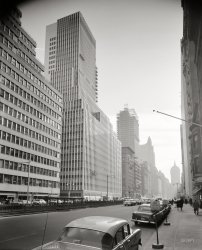
- Along the El: 1907
- ... Building remain. The Silversmith is now a boutique hotel.
Also visible are examples of the " ... Posted by Dave - 07/30/2012 - 10:08pm -
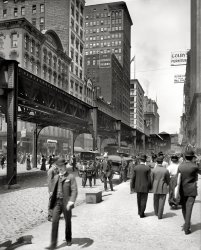
- Walter's Restaurant: 1953
- ... Gorham, my uncle, ran this restaurant in the Mary-Etta Hotel. View full size.
RE: That was my home! Thanks for your ...
"Noted for Good Food" The Mary-Etta Hotel as pictured on a matchbook cover
That was my home! I grew up in ... Posted by Jack Gorham - 08/06/2017 - 6:11pm -
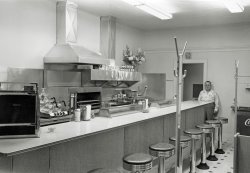
- Glamour Shot: 1947
- ... Horseshoe" used to be in a cellar space of the Paramount Hotel on 46th Street in NYC. Up until last year the nightclub space was not ... I think). A NY real estate investor recently bought the hotel, renovated the Diamond Horseshoe and installed a new state of the art ... Posted by Dave - 10/17/2014 - 11:40am -
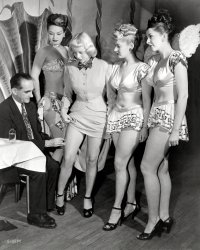
- Good Shoes: 1903
- ... down the block, on the right between Keith's and the Hotel) is still there, as is the taller building with the ornate windows a bit ... Posted by Dave - 08/09/2012 - 2:43pm -
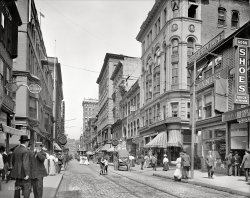
- Bustling Detroit: 1915
- ... in this panorama of two 8x10 glass negatives are the Hotel Pontchartrain, Soldiers' & Sailors' Monument, Ford Building, Detroit ... Posted by Dave - 07/28/2012 - 4:11pm -
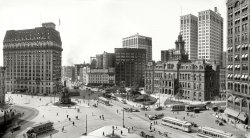
- New York: 1910
- ... by John Jacob Astor in 1836 and was considered the finest hotel in New York City for decades. It has been considered the direct ancestor to the Astor Hotel that was on Times Square and the two Waldorf-Astorias (the first on Fifth ... Posted by Dave - 08/14/2012 - 8:48pm -
![New York: 1910 Lower Manhattan circa 1910. "Hudson Terminal buildings." 8x10 inch dry plate glass negative, Detroit Publishing Company. View full size.
Tower of PowerWhat would the open ironwork tower in the upper left have been for? Much too small for a water tower, could it have been an observation post for fires? Or perhaps for steamship arrivals (before the terminal buildings were built)? Maybe a weather station? Or a wireless mast?
Pre-WTCI've always wanted to see a better shot of these buildings, as they were so overlooked.
(It's also interesting to see this particular shot on this particular day as well, considering what was built there.)
Fit for FishingThe sign on the right says, "Fishing Tackle That's Fit For Fishing, Abercrombie."
[You're close -- it's Abbey & Imbrie. - Dave]
Nice understatementThe Hudson Terminal Buildings were located on the future site of the World Trade Center, weren't they?
I like this one.This is a great photo!
Early Twin TowersUnbelievable shot Dave. An appropriate tribute to 9/11 and a reminder we must never forget the ATTACKS (they were not "tragic events") that day in 2001. This view is from Park Row looking southwest. Those towers stood on what was to become the World Trade Center site. The roof of the Astor House can be seen in the immediate foreground which stood on Broadway between Vesey and Barclay Streets. It was built by John Jacob Astor in 1836 and was considered the finest hotel in New York City for decades. It has been considered the direct ancestor to the Astor Hotel that was on Times Square and the two Waldorf-Astorias (the first on Fifth and the current one on Park). It was demolished in sections beginning in 1913. St. Paul's Chapel in the left foreground still stands today. For months after 9/11 the fence around St. Paul's was completely covered in hand-made signs asking for help in locating those who were missing after the attacks. That is something I'll never forget.
A sad bit of ironythe ground floor of the old Evening Post building at 20 Vesey Street houses the 9/11 Memorial Preview Site.
Found! Titanic link!So here we see the test lab for the Titanic's deck chairs.
Colossal structures of the past.We don't have that tall buildings here in Finland even now (Well, maybe one or two). And that was 100 years ago. I guess there's lots of space here. No need to "go up." But that's still pretty impressive! Shame that those are not around anymore, they would have also made a lot more difficult target to hit, than WTC. Btw, I think it's kinda ironic that now they build world's tallest buildings in the middle east (Burj Khalifa in Dubai and that new colossal clock tower in Mecca. I'm just waiting for the news that some American has snapped and had enough and decided to even up the score some with a plane of his own.)
P.S. I did see the attack in N.Y. coming years ahead (But the scenario I speculated to happen, was a terrorist nuclear attack in N.Y.), as I did see the end of Soviet Union coming and the falling of berlin wall. Nobody never believes me before these things actually happen. (I'm no fortune teller, I jus't follow things going on in the world and use common sense to put 2+2 together)
Chim Chiminey45 (?) chimneys, countless steam pipes and one water tank! I find rooftops the absolute most interesting parts of old building!
New York Law SchoolFWIW, New York Law School was started by several Columbia University Law School professors who had philosophical and pedagological differences with the Columbia Universtiy administration.
Attractive BuildingsThe Hudson Terminal buildings look quite attractive. It may be blasphemous to say this but I was never a fan of the architecture in the WTC buildings.
Rooftop VentsWhat are those oblong chimney-like structures seen on the roofs of several buildings? Could they be fireplace exhausts?
[Your hunch is correct: The chimneylike things are chimneys! - Dave]
So beautifulWhat a poignant window on the past. Amazing how events, when filtered through time and knowledge and experience, backwards and forwards, fraught as they are with emotion, take on new meaning. Now when I see a movie with the WTC towers standing insouciantly in the background, unaware of their fate, I get a catch in my throat. Similarly to visit NYC and just look at the air where they stood, presents a moment of listening and learning if you let it.
(The Gallery, DPC, NYC)](https://www.shorpy.com/files/images/4a18634a.thumbnail.jpg)
- Gotham Noir: 1933
- ... 15, 1933. "New York city views. Financial district from Hotel Bossert." Large-format acetate negative by Gottscho-Schleisner. View ... have any way of knowing that.
For many years, the Hotel Bossert in Brooklyn Heights was owned by the Jehovah's Witnesses as part ... Posted by Dave - 05/29/2013 - 2:27pm -
![Gotham Noir: 1933 March 15, 1933. "New York city views. Financial district from Hotel Bossert." Large-format acetate negative by Gottscho-Schleisner. View full size.
Tallest buildingsThe three tall buildings in the center of this view, from left to right: 20 Exchange Place (flat top); 40 Wall Street, aka the Trump Building (dark spire top); and 70 Pine Street, formerly the Cities Service Building (light spire top). None were more than a couple years old when this picture was taken.
What with the Great Depression and then World War II, there wouldn't be any more significant skyscraper construction for many years, and when construction finally resumed most buildings would have the more contemporary curtain-wall appearance. Masonry construction as seen in these buildings would seldom be used again. Samuel Gottscho really was documenting the end of an era in this picture, though of course he didn't have any way of knowing that.
For many years, the Hotel Bossert in Brooklyn Heights was owned by the Jehovah's Witnesses as part of their vast (4+ million square feet) Brooklyn headquarters complex. A few years ago, however, the denomination rather abruptly announced that it would be moving about 30 miles upstate and put all of the Brooklyn properties on the market. A private developer bought the Hotel Bossert about a year ago and announced plans to convert it into an upscale "boutique hotel." I don't know how much if anything has been done.
[Note: Samuel Gottscho may not have been able to predict the decline of commercial construction, but he was able to cope with it. When his business of architectural photography tailed off, he switched to nature and botanical photography and became highly acclaimed in that field. An interesting bit of trivia is that he did not take up photography until age 50, yet remained active until shortly before his death in his late 90's.]
WowMy new desktop for sure.
Of Time and the RiverI like to think that this stunning scene is just about what Thomas Wolfe could see from his Brooklyn apartment when he gazed at Manhattan in 1933.
Wow indeedI think that pretty much sums it up.
Looked so much betterThe setbacks formed such a better looking skyline than the modern rectangle boxes. I'm no fan of the International style.
What Time of Day?When do you think this picture was taken? Maybe early morning - sky/clouds visible and light reflections on one side of the buildings? Or was it one of the "filter" tricks to just make it look like night? I couldn't help but notice that there are no lights on in any of the buildings.
[Sunset. West is to the left. - Dave]
(The Gallery, Boats & Bridges, Gottscho-Schleisner, NYC)](https://www.shorpy.com/files/images/SHORPY_5a18138u.thumbnail.jpg)
- Final Curtain: 1904
- ...
Out of view to the right of the picture was Flagler's Hotel Royal Poinciana.
What a cosmic joke that would be Rip Van Winkle ... Posted by Dave - 08/20/2012 - 10:49am -
